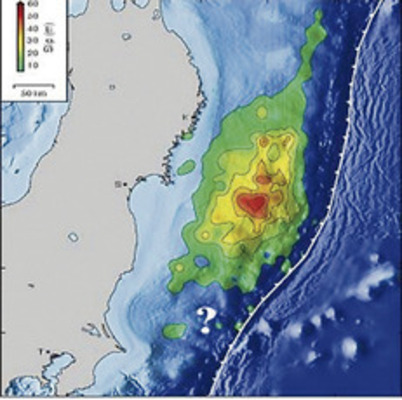Small area bore brunt of earthquake’s force

Mark Simons / Caltech Seismological Laboratory This image represents the estimated fault slip due to the March 11 quake off Japan. The fault responsible for the quake dips under Japan, starting at the Japan Trench (indicated by the barbed line), which is the point of contact between the subducting Pacific Plate and the overriding Okhotsk Plate. The magnitude of fault slip is indicated by the color and contours, which are at 8-meter intervals. The question mark is the region where researchers lack information about future seismic potential.
Like a double charge of powder in a cannon, the March 11 earthquake off Japan was focused in a sea-floor area half the size expected for such a large movement of earth, Caltech scientists have calculated.
And their study has called attention to an area just south of the quake zone, which they say has geophysical similarities.
"It is important to note that we are not predicting an earthquake here," Mark Simons, a professor of geophysics at Caltech’s Seismological Laboratory, said of the area to the south. "However, we do not have data on the area, and therefore should focus attention there, given its proximity to Tokyo."
The length of fault that experienced significant slip during the 9.0-magnitude quake was about 155 miles, says Simons. Furthermore, the section where the fault slipped the most — by 98 feet or more — was only 30 to 60 miles long, according to Simons.
"This is not something we have documented before," says Simons. "I’m sure it has happened in the past, but technology has advanced only in the past 10 to 15 years to the point where we can measure these slips much more accurately through GPS and other data."
The first large set of observational data from the quake, which scientists are calling a "megathrust event," were detailed online May 19 in Science Express.
Don't miss out on what's happening!
Stay in touch with breaking news, as it happens, conveniently in your email inbox. It's FREE!
The quake occurred at a subduction zone where the Pacific plate dips below Japan. Simons says the pressure along the zone might have been building for 500 to 1,000 years.




